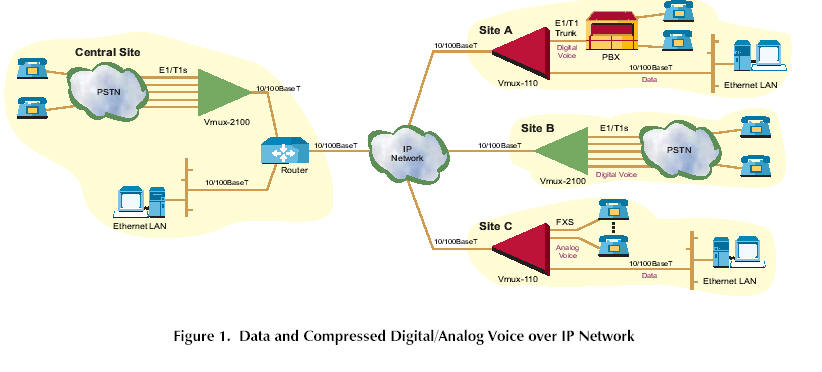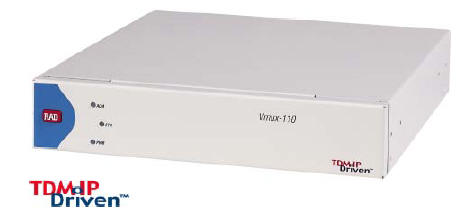|
FEATURES
-
Supports bandwidth efficient
transmission of one E1, T1 or (4) FXS ports over IP or a single fractional
TDM link.
-
Simultaneous transmission over
IP and TDM networks
-
Unique TDMoIP Multiplexing,
together with various voice compression algorithms, provides up to 16:1
effective bandwidth utilization
-
Bandwidth is dynamically
allocated according to Voice Activity Detection and silence suppression
-
G.168 Echo Cancellation of up to
16 msec per channel
-
Group III Fax relay support, at
rates of 2.4 to 14.4 kbps
-
Transparent modem support for
all common rates and standards
-
QoS support:
-
Supports HDLC Channel
Compression
-
DTMF/MFR2/MFC signal detection,
generation and relay
-
Signaling supported:
-
Transparent CAS signaling,
including R2 and E&M
-
Transparent CCS signaling,
including ISDN, QSIG and SS7
-
Management via user terminal,
secured SNMP and Telnet
-
Enhanced local and remote
diagnostics tools
-
Compact 1U-high platform,
compatible with 19" racks
Vmux-110 is a
customer-located device that complements the
larger modular Vmux-2100 system, fulfilling the need for a
low capacity remote voice trunking gateway for both IP and
leased line TDM networks.
Vmux-110 is available with
either an E1 or T1 port for digital voice channels, or four FXS ports for
analog POTS. Vmux-110 compresses the voice traffic and transports it over
either a serial TDM link, or a 10/100BaseT IP link. The device employs
G.723.1, G.729 Annex A and G.711 compression algorithms together with RAD?s
unique TDMoIP multiplexing, including transparent CAS and CCS signaling. A
second 10/100BaseT port is provided for connecting a user Ethernet LAN to
the unit. Together with Vmux-110?s integral Ethernet switch, this allows
integrating the user LAN traffic with the compressed voice, over a single
uplink (IP or serial) to the network.
Voice Activity Detection (VAD)
and silence suppression allow Vmux units to dynamically allocate bandwidth
for voice traffic. This results in very efficient bandwidth usage, leaving
more bandwidth for data transport. By preventing packets from being sent
when no voice activity is detected, the VAD mechanism conserves bandwidth.
The improved bandwidth utilization enables Vmux-110 to support a higher
number of channels than is possible by using conventional voice compression
methods alone.
By performing TDMoIP
multiplexing and grouping the timeslots of G.723.1 compressed voice together
into bundles with a common IP address, actual link bandwidth used can be
reduced to as low as 4 kbps per channel (a reduction of 16:1). CAS and CCS
signaling are transparently transmitted end-to-end. Vmux-110 transmits HDLC-based
CCS signaling protocols such as SS7, ISDN and QSIG as HDLC over IP. HDLC
frames are removed, and any signal payload is sent in an IP packet. For ISDN
and QSIG protocols, this results in significant bandwidth savings.
For deployment
optimization, Vmux-110 with E1 or T1 voice ports can be ordered to compress
6, 12, 18, 24 (for full T1 trunk) or 30 timeslots (for full E1 trunk). Each
timeslot carries a single digital voice channel. Vmux-110 is a compact, 1U
high, half 19" wide unit that can be mounted in standard 19" racks.
SPECIFICATIONS
NETWORK PORTS
Vmux-110 provides two 10/100BaseT Ethernet ports and one n x 64 kbps serial
link. Ethernet Ports
? Standards
IEEE802.3, 802.3u, Ethernet, 802.1p&q
? Data Rate
10 or 100 Mbps, half duplex or full duplex, auto-negotiate
? Statistics
According to RFC 1643, or RFC 2665:
Received frames:
Correct Frames, Correct Octets, Alignment Errors, FCS Errors.
Transmitted frames:
Correct Frames, Correct Octets, Single Collision, Multiple Collision,
Deferred Transmission, Late Collision,
Carrier Sense Error
? Copper UTP Interface
Range: up to 100m on UTP Cat.5 cable
Connector: RJ-45 (per port) Serial Link
? Data Rate
n x 64 kbps, up to 2048 kbps
? Interface
Selectable for RS-530, V.35 or X.21
? Connector
DB-25, female
(For V.35 or X.21 interface, an adaptor cable is required ? see
Ordering)
? Clock Modes
DCE: Vmux-110 provides clock to connected equipment
DTE: Vmux-110 accepts clock from connected equipment
(requires adaptor cable)
VOICE PORTS
Vmux-110 is available with choice of single E1 or T1 voice port, or 4 x FXS
analog voice ports.
? Compression Algorithms
G.723.1 (5.3 or 6.4 kbps), G.729 A (8 kbps), G.711 (a-law or ?-law)
? Silence Suppression
G.723.1 A, G.729B
? Echo Cancellation
16 msec per channel as per G.168
? Fax Relay
Group III: 4.8, 9.6, 14.4 kbps
? Voice Band Data
Transparent support for modems
? Signaling Support
Transparent CAS, including R2 and E&M
Transparent CCS, including ISDN, QSIG and SS7
? MF Signaling Support
DTMF, MFR2, MFC detection, generation and relay
E1 Digital Voice Port
? Number of Channels Supported
According to ordering: Up to 6, 12, 18, 24 or 30
? Nominal Data Rate
2.048 Mbps
? Standards
ITU-T Rec. G.703, G.704, G.706, G.732, G.823
? Framing
G.732N or G.732S, with or without CRC-4
? Line Code
HDB3
? Receive Signal Level
With LTU: 0 to -43 dB
Without LTU: 0 to -12 dB
? Transmit Signal Level
Balanced: ?3V (?10%)
? Timing
Internal or loopback
? Jitter Performance
Per ITU-T G.823
? Line Type
Balanced: 4-wire, 120Ω
Unbalanced: Coax, 75Ω
? Connectors
Balanced: RJ-45 Unbalanced: pair of BNC
T1 Digital Voice Port
? Number of Channels Supported
According to ordering: Up to 6, 12, 18 or 24
? Nominal Data Rate
1.544 Mbps
? Standards
ANSI T1.403, AT&T TR-62411, ITU-T Rec. G.703
? Framing
SF, ESF
? Line Code
AMI
? Zero Suppression
B8ZS
? Timing
Internal or loopback
? Receive Signal Level
With CSU: 0 to -36 dB
Without CSU: 0 to -30 dB
? Transmit Signal Level
With CSU: 0, -7.5, -15, or -22.5dB
Without CSU: ?2.7V (?10%) at 0-655 ft
? Jitter Performance
Per AT&T TR-62411
? Line Type
Balanced 4-wire, 100Ω
? Connector
RJ-45 FXS Analog Voice Ports
? Number of Ports
4
? Analog Parameters
ITU-T standards: G.713, 2-wire for voice and signaling.
Nominal level : 0 dBm
Nominal impedance : 600Ω
Return loss (300 to 3400 Hz): better than 20 dB
Frequency response (Ref: 1020 Hz):
300 to 3000 Hz: ?0.5 dB
250 to 3400 Hz: ?1.1 dB
Level adjustment, soft selectable:
TX: +5 dBm to -10 dBm
RX: +5 dBm to -10 dBm
Steps: 2 dB (?0.1 dB), nominal
Signal to total distortion, G.712, G.713 method 2:
0 to -30 dBm0: better than 33dB
+3 to -45 dBm0: better than 22dB
Idle channel noise: better than -70 dBm0 (+20 dBrnc)
? Signaling
EIA RS-464 Loop-Start
On-Hook/Off-Hook Threshold: 3V to 24V between TIP and
RING at off-hook state
Higher than 25V between TIP and RING at on-hook state
Feed Current:
24 mA ?10%
Ringer:
Voltage: 50 VRMS (?10%), overload protected
Frequency: 25 Hz (?10%)
Cadence: 1 sec ON / 3 sec OFF
(default), user-configurable
? Connectors (per port)
RJ-11
CONTROL PORT
? Standards
RS-232/V.24 (DCE)
? Data Rate
9.6, 19.2, 38.4, 57.6 or
115.2 kbps
? Connector
RJ-45
GENERAL
? Diagnostics
Ethernet Ports:
Performance monitoring, LAN statistics, PING
E1/T1 Voice Ports: Local and Remote Loops on entire E1/T1
Tone injection per timeslot towards local side
FXS Voice Ports: Local and Remote Loops per channel
Tone injection per channel towards local side
? Indicators
PWR (green) ? Indicates when power is on
ETH (green) ? ON when Ethernet line is O.K.
ALM (red) ? Indicates alarm is present in system
? Physical
Height: 4.3 cm/1.7 in
Width: 21.5 cm/8.5 in
Depth: 23.7 cm/9.3 in
Weight: 2.0 kg/4.4 lb
? Power (according to ordering)
Input:
AC: 100 to 240 VAC, 50/60 Hz
48: -36 to -72 VDC
Consumption:
4FXS: AC: 13.5W;
DC: 12.5W
E1/T1: AC: 10.2W;
DC: 9.0W
? Environment
Operating temperature:
0 to 50?C/32 to 122?F
Storage temperature:
-20 to 70?C/-4 to 158?F
Humidity: Up to 90%, non-condensing
ORDERING
VMUX-110/*/+/ETH-UTP
Voice Trunking Gateway
* Specify
power supply:
AC for 100
to 240 VAC
48 for -48
(-36 to -72) VDC
+ Specify
voice port type:
E1/~ for E1
digital voice port
T1/~ for T1
digital voice port
4FXS for 4
analog FXS ports
~ Specify
number of channels
supported by digital voice port:
6 for up to
6 channels
12 for up to
12 channels
18 for up to
18 channels
24 for up to
24 channels
30 for up to 30 channels (E1 only)
CBL-VM110/?
Serial link adaptor cable
? Specify interface and clock mode:
V35/DCE for V.35, DCE mode
V35/DTE for V.35, DTE mode
X21/DCE for X.21, DCE mode
X21/DTE for X.21, DTE mode
530/DTE for RS-530, DTE mode
Note: An adaptor cable is not required for
connecting to RS-530 equipment when
Vmux-110 operates in DCE clock mode.
RM-35
Hardware for mounting one or two
Vmux-110 units in a 19-inch rack
APPLICATION


|

